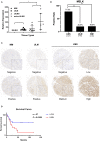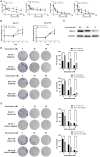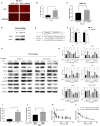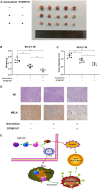Upregulated MELK Leads to Doxorubicin Chemoresistance and M2 Macrophage Polarization via the miR-34a/JAK2/STAT3 Pathway in Uterine Leiomyosarcoma
- PMID: 32391256
- PMCID: PMC7188922
- DOI: 10.3389/fonc.2020.00453
Upregulated MELK Leads to Doxorubicin Chemoresistance and M2 Macrophage Polarization via the miR-34a/JAK2/STAT3 Pathway in Uterine Leiomyosarcoma
Abstract
Uterine leiomyosarcoma (ULMS) is the most lethal gynecologic malignancy with few therapeutic options. Chemoresistance prevails as a major hurdle in treating this malignancy, yet the mechanism of chemoresistance remains largely unclear. In this study, we certified MELK as a poor prognostic marker through bioinformatic analysis of the GEO database. Cellular experiments in vitro revealed that MELK played an essential role in ULMS cells' chemoresistance and that a high expression of MELK could lead to doxorubicin resistance. mRNA profiling uncovered the pathways that MELK was involved in which led to doxorubicin resistance. MELK was found to affect ULMS cells' chemoresistance through an anti-apoptotic mechanism via the JAK2/STAT3 pathway. miRNA profiling also revealed that upregulated MELK could induce the decrease of miRNA-34a (regulated by JAK2/STAT3 pathway). We detected that MELK overexpression could induce M2 macrophage polarization via the miR-34a/JAK2/STAT3 pathway, contributing to doxorubicin chemoresistance in the tumor microenvironment. OTSSP167, a MELK inhibitor, may increase ULMS sensitivity to doxorubicin. Our investigation could propose novel targets for early diagnosis and precision therapy in ULMS patients.
Keywords: JAK2; M2 macrophage; MELK; STAT3; apoptosis; chemoresistance; uterine leiomyosarcoma.
Copyright © 2020 Zhang, Sun, Li, Jiao, Griffin, Dongol, Wu, Zhang, Cao, Dong, Yang, Zhang and Kong.
Figures





Similar articles
-
Upregulation of MELK promotes chemoresistance and induces macrophage M2 polarization via CSF-1/JAK2/STAT3 pathway in gastric cancer.Cancer Cell Int. 2024 Aug 12;24(1):287. doi: 10.1186/s12935-024-03453-8. Cancer Cell Int. 2024. PMID: 39135038 Free PMC article.
-
LncRNA NEAT1 sponges miR-214 to regulate M2 macrophage polarization by regulation of B7-H3 in multiple myeloma.Mol Immunol. 2020 Jan;117:20-28. doi: 10.1016/j.molimm.2019.10.026. Epub 2019 Nov 12. Mol Immunol. 2020. PMID: 31731055
-
Clinical Benefit in Response to Palbociclib Treatment in Refractory Uterine Leiomyosarcomas with a Common CDKN2A Alteration.Oncologist. 2017 Apr;22(4):416-421. doi: 10.1634/theoncologist.2016-0310. Epub 2017 Mar 10. Oncologist. 2017. PMID: 28283584 Free PMC article.
-
Current state of the art and emerging pharmacotherapy for uterine leiomyosarcomas.Expert Opin Pharmacother. 2019 Apr;20(6):713-723. doi: 10.1080/14656566.2019.1571042. Epub 2019 Feb 6. Expert Opin Pharmacother. 2019. PMID: 30724615 Review.
-
The role of adjuvant therapy in uterine leiomyosarcoma.Expert Rev Anticancer Ther. 2016;16(1):45-55. doi: 10.1586/14737140.2016.1115724. Epub 2015 Nov 26. Expert Rev Anticancer Ther. 2016. PMID: 26558647 Free PMC article. Review.
Cited by
-
Upregulation of MELK promotes chemoresistance and induces macrophage M2 polarization via CSF-1/JAK2/STAT3 pathway in gastric cancer.Cancer Cell Int. 2024 Aug 12;24(1):287. doi: 10.1186/s12935-024-03453-8. Cancer Cell Int. 2024. PMID: 39135038 Free PMC article.
-
Integrated bioinformatics analysis and experimental validation reveals hub genes of rheumatoid arthritis.Exp Ther Med. 2023 Aug 25;26(4):480. doi: 10.3892/etm.2023.12179. eCollection 2023 Oct. Exp Ther Med. 2023. PMID: 37745040 Free PMC article.
-
The Role of Non-Coding RNAs as Prognostic Factor, Predictor of Drug Response or Resistance and Pharmacological Targets, in the Cutaneous Squamous Cell Carcinoma.Cancers (Basel). 2020 Sep 8;12(9):2552. doi: 10.3390/cancers12092552. Cancers (Basel). 2020. PMID: 32911687 Free PMC article. Review.
-
MUC21 induces the viability and migration of glioblastoma via the STAT3/AKT pathway.Exp Ther Med. 2022 May;23(5):331. doi: 10.3892/etm.2022.11260. Epub 2022 Mar 16. Exp Ther Med. 2022. PMID: 35401801 Free PMC article.
-
p53 isoform expression promotes a stemness phenotype and inhibits doxorubicin sensitivity in breast cancer.Cell Death Dis. 2023 Aug 8;14(8):509. doi: 10.1038/s41419-023-06031-4. Cell Death Dis. 2023. PMID: 37553320 Free PMC article.
References
-
- Tominaga T, Abe O, Enomoto K, Abe R, Iino Y, Koyama H, et al. . A randomized controlled study of (2"R)-4'-O-tetrahydropyranyladriamycin and adriamycin in combination with cyclophosphamide and 5-fluorouracil in the treatment of advanced and recurrent breast cancer. Clinical Study Group of THP for breast cancer in Japan. Biomed Pharmacother. (1989) 43:271–8. 10.1016/0753-3322(89)90008-5 - DOI - PubMed
-
- Pautier P, Floquet A, Penel N, Piperno-Neumann S, Isambert N, Rey A, et al. . Randomized multicenter and stratified phase II study of gemcitabine alone versus gemcitabine and docetaxel in patients with metastatic or relapsed leiomyosarcomas: a Federation Nationale des Centres de Lutte Contre le Cancer (FNCLCC) French Sarcoma Group Study (TAXOGEM study). Oncologist. (2012) 17:1213–20. 10.1634/theoncologist.2011-0467 - DOI - PMC - PubMed
LinkOut - more resources
Full Text Sources
Molecular Biology Databases
Miscellaneous

